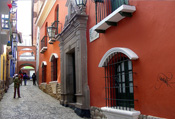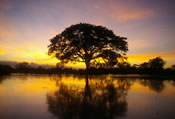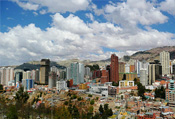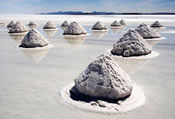 |
 |
|||
 |
 |
|||
BACKGROUND INFORMATIONWith a population estimated at over nine million inhabitants Bolivia is bordered on the north and east by Brazil, on the southeast by Paraguay , on the south by Argentina and on the west by Chile and Peru . It is with Paraguay the only land locked countries in South America . La Paz , the administrative capital of the country is the highest capital city in the world with 36000 meters. ( Sucre retains the constitutional capital). National languages: Spanish, Aymara, Quechua.
La Paz has many modern and comfortable hotels, good restaurants, bars and night clubs ( that open generally at mid-night). Her main tourist attractions are the Presidential Palace, the Cathedral, the churches of San Francisco and Santo Domingo , the National Museum, the Moon Valley .
Lake Titicaca worshipped by the Indians as they believed the civilization started on the Sun Island. It is the world’s highest navigable lake, shared by both Bolivia and Peru . Here one should visit the Sun and Moon Islands and the shrine of our Lady of Copacabana and their pre-Columbian remains.
Santa Cruz de la Sierra is located in eastern Bolivia on the banks of the Pirai River . It is a thriving metropolis with Bolivian cities’ largest urban population. This city enjoys an average temperature of 21.o Celsius. Its main attractions are the cathedral and its museum that date back from the XVII century, the museum of Natural History and 24 of September Square. Just 50 kilometers away is the village of Cotoca famous for its shrine. Here there is a pilgrimage once a year to pay tribute to Our Lady of Cotoca. This village is also famous for its works in pottery, a skill that the locals have developed along the years. Santa Cruz is also the gateway to the Jesuit Missions of Chiquitos, appointed Patrimony of the Humanity by UNESCO: San Javier’s, the closest one is only 220 kilometers by paved road. The distances between the other missions vary from 69 to 206 kilometers from each other by unpaved road.
Cochabamba also named “The Garden City” enjoys enviable weather, an average of 17 Celsius in winter and 26 Celsius in summer. Famous for its culture and folklore its highlights are the huge statue of Christ of La Concordia, La Coronilla, dedicated to some courageous women that once defended the city from the Spaniards, Palacio Portales and Villa Albina, where Patino, the Tin Baron, and his wife used to reside, and the cathedral that dates from 1571. Sucre, declared a world heritage site by UNESCO, is a charming historical city with many colonial churches and museums. San Francisco Xavier University founded here in 1624, is one of the oldest universities of South America . |
||||
Latin World Tours
Tour Operators in Toronto

|